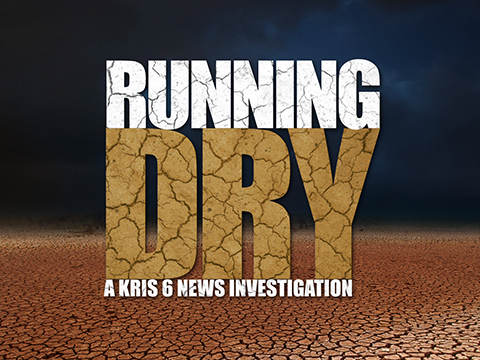CORPUS CHRISTI, Tx — A major credit rating company is warning that Corpus Christi's water crisis could cost the city money.
Fitch Ratings changed its outlook on the city's water and utility bonds from "stable" to "negative" last week. Think of it like a warning light on your car dashboard — the city's credit score is still good, but there are problems ahead if things don't improve.
The city has about $1.19 billion in outstanding utility system bonds rated AA- by Fitch. If Fitch downgrades the city's rating, it could cost ratepayers more money when the city needs to borrow in the future.
City Manager: We Expected This
City Manager Peter Zanoni sent a message to the mayor and city council on Tuesday explaining the situation.
"Last week, Fitch Ratings kept our 'AA-' rating on the City's utility debt," Zanoni wrote. "But they changed their outlook to 'negative' from 'stable.'"
He said Fitch is worried about two things, "the City’s ongoing severe drought and their perceived risk of advancing the Evangeline and Effluent Reuse projects by November 2026."
"Fitch Ratings stated that they are likely to return the outlook to ‘stable’ if the City continues to successfully secure additional water supplies to improve water resiliency," Zanoni wrote.
In his message to city council, Zanoni said this isn't new. "Standard and Poor's" — another big rating company — said basically the same thing a few weeks ago.
What Happens in November 2026?
That's when things could get bad.
Fitch's report says the city's project that the "western surface water reservoirs will reach critical levels with a Level 1 Water Emergency anticipated by November 2026 absent meaningful drought relief."
As KRIS 6 News has previously reported, the city needs 60 million gallons of new water every day before that deadline.
What does a Level 1 Water Emergency mean? Everyone — homes, businesses, and factories — would have to use 25% less water.
In September, the city council voted to not move forward with design on the Inner Harbor Seawater Desalination plant. That heated meeting lasted 13 hours, and ended with the council voting 6-3 to not move forward with design because of the high cost.
However, Fitch said canceling the plant created more uncertainty.
"The city has canceled plans for a new desalination (desal) plant. Management already expected the water supply to reach critically low levels prior to the cancellation, but the desal plant would have provided a more definitive timeline for conservation and curtailment before new supplies became available. The cancellation of the desal project increases uncertainty regarding the timeline for this additional supply," the report said.
According to a presentation posted by the city's water department in late October, Corpus Christi has outlined three scenarios to delay or avoid triggering a Level 1 Water Emergency. All scenarios assume baseline conditions including 70 million gallons per day from the Mary Rhodes Pipeline, 10 million gallons per day from the Eastern Nueces Well Field starting October 2025, and no interruptions to operations. Under current conditions with no additional water supply projects beyond the baseline, the city projects hitting the emergency threshold by November 2026.
Alternative scenarios include:
Scenario 1: Assumes the Eastern and Western Nueces Well Fields come online by May 2026, producing a combined 28 million gallons per day—this would push the emergency declaration to May 2027.
Scenario 2: Adds Evangeline aquifer wells (12 million gallons per day by December 2027, with another 12 million gallons per day by December 2028) plus wastewater effluent reuse starting at 3 million gallons per day in November 2026 and expanding to 16 million gallons per day by December 2028. This extends the timeline to December 2027.
Scenario 3: Accelerates the Evangeline wells to November 2026 and December 2027, while starting wastewater effluent reuse in July 2027—potentially avoiding a Level 1 Water Emergency altogether.
However, Fitch cautions that these alternative supply projects remain "subject to permitting and best-case construction timelines, heightening execution risk"—meaning delays in regulatory approval or construction could quickly erode the city's water supply cushion and force emergency conservation measures sooner than projected.
Money Problems on Top of Water Problems
Fitch also warned about the city's debt.
The city has borrowed a lot of money to pay for water projects. Right now, the city's debt compared to its income is at 8.0. That's good. But Fitch thinks it could jump to 10.9 next year because of all the new projects.
Higher debt plus uncertain water supply equals bad news for the city's credit rating.
Councilmember Roland Barrera said Fitch's outlook sends a clear message about the risks of the city’s water strategy.
“If there’s uncertainty for large, consistent ratepayers who’ve spent billions in the city… there’s a consequence associated with that,” Barrera said. He criticized the decision to cancel the Inner Harbor desalination plant — a project that already had permits and funding — in favor of alternatives like the Evangeline groundwater, which still face regulatory and financial hurdles.
Water rates are already set to rise by about $8 next October to cover the failed desal project. Barrera warned that Fitch’s downgrade could make borrowing more expensive and push those rates even higher.
“It could be more than the eight dollars, absolutely,” he said.
What Does "Negative Outlook" Actually Mean?
Think of it like a warning from your doctor. Your health is okay today, but if you don't change things soon, you'll get sick.
A "negative outlook" means Fitch could lower the city's rating in the next year or two if:
The city doesn't get enough water in the next 1-2 years
The city's debt stays too high for too long
But the outlook could go back to "stable" if the city finishes its water projects on time and gets the water it needs.
For the latest local news updates, click here, or download the KRIS 6 News App.



